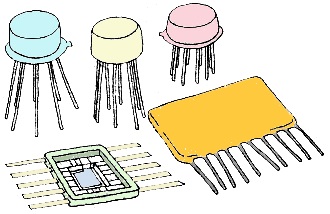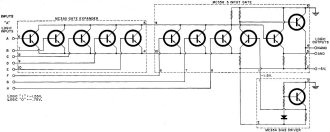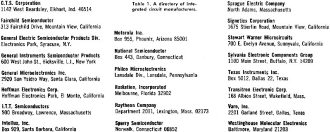Integrated Circuits: What's Available?
|
|
The November 1965 issue of Electronics World magazine featured a set of articles reporting on the fledgling semiconductor industry. The title of this one, "Integrated Circuits: What's Available?" would require volumes to print today, but at the time the selection could be summed up with a relatively small amount of paper and ink. Author Donald Lancaster exuberantly and correctly predicted some of the many products and uses that miniaturization and capability the burgeoning technology would enable. Among them he cites desk[top] computers priced lower than mechanical adding machines, picture-on-the-wall TV, truly portable communications, vehicular anti-collision devices, precision counters, clocks, and controls. That's impressive foresight. That's pretty impressive. He further mentions extended (compared to vacuum tubes) temperature and frequency ranges, along with greater mechanical robustness. Of course prices would rapidly drop not only for the semiconductor devices themselves, but for the accompanying parts and products they are designed into. Integrated Circuits: What's Available?
Integrated circuits, some at low prices, are starting to appear on distributors' shelves. Here is a brief description of typical units, some practical circuits, and a directory of manufacturers. By Donald Lancaster Advancing technology and fierce competition in the integrated circuits field have resulted in a large number of readily available, low-cost, distributor-stock circuits that can outperform, out-price, and outlast conventional discrete circuitry. These devices are no longer dream components of the aerospace industry but are here now, ready for immediate application. On the distributors' shelves today are entire logic circuits, including memory and counting flip-flops, gates, adders, expanders, bias sources, and shift registers. And what amazing devices they are. One shift register in a single TO-5 type can is able to count to 100 contains over 600 transistors. and sells for a tiny fraction of the cost of conventional circuitry. For decoding and indicating, low-cost dual latches are available. For counting, single-can decade counters are available for less than $25 each. Dual-decade counters that count to 100 and indicate each number in between are also available. For level detecting and comparing, differential comparators that readily become variable-threshold Schmitt triggers are now in stock. The amplifiers are even more impressive. One operates from d.c. to 30 mc. with a voltage gain of 2500. A second unit gives 26 db of power gain at 100 mc. A third produces a full watt of audio output into a speaker with very low distortion and consumes very little standby power. Fig. 1 - The three-input MC356 gate can be extended to eight inputs with a MC355 gate expander. Bias driver MC354 supplies the -1.15-V. reference signal for the gate. Each of these devices is contained totally within a single TO-5 size can. And this is only the bare beginning, the results of a few short months' work in a new technology. The impact on space electronics has already been huge. Give integrateds several more years, and totally undreamed of electronic circuitry will be commonplace. Circuits now impossible or extremely complex will soon become common through microminiaturization techniques. We can soon anticipate desk computers priced lower than mechanical adding machines, picture-on-the-wall TV, truly portable communications, vehicular anticollision devices, precision counters, clocks, and controls. And with these, an entire new era of consumer electronic devices will begin. Table 1 lists most integrated-circuit manufacturers. How Much Do They Cost? The pricing of some integrateds is genuinely low. One manufacturer (Fairchild) recently announced the feasibility of counting flip-flops in epoxy cases for less than a dollar in quantity. Today you can buy a counting flip-flop for under $4, a five-input logic gate for $3.55, and a bias driver for only $2.25. And these are single-quantity prices that radically drop as the numbers increase. Other integrateds are expensive, ranging between $15 and $75 each, but when total system costs, including labor and assembly, are considered, they are usually substantially less than the cost required to design, evaluate, and produce similar discrete circuitry. These circuits offer decided performance advantages, notably in regard to wide temperature operation, stability, balance, and frequency response. How Valuable? One might inquire what value integrated circuits are where space, weight, and supply power are not acute design problems. To these obvious advantages, we can now add a lower per-circuit cost. Reliability is considerably enhanced since there are fewer soldered joints and fewer interconnections to contend with. Connections, particularly supply runs, are much simpler. Smaller sizes and fewer components result in low mechanical inertia and high shock resistance. Integrated circuits constitute a total silicon technology and are potentially useful over a -55 to +125°C temperature range, while many newer forms are highly radiation resistant. Each integrated circuit has a guaranteed and specified temperature range, input loading, output capability, and noise immunity. This largely eliminates the temperature tests, environmental checks, loading tests, etc., that commonly plague the discrete circuit designer, for all these tests have already been performed at the can level. All the transistors in many integrateds are built up out of the same slice of silicon. This means inherent temperature tracking, greatly minimizing drift and offset problems in low-level circuits. Furthermore, integrateds are inherently faster and operate higher in frequency because of their shorter interconnecting leads and the smaller junction sizes. Finally, the locked-in circuit configuration provides precise control of parasitic capacitance and inductance, giving easily reproducible results in high-gain or high-frequency work. What Types Are Available? The three most common integrated packages are the flat pack, the TO-5 modified can with 8, 10, or 12 leads, and the dipped-substrate package. The flat pack usually measures 250 mils square by 60 mils or so thick and is accompanied by eight or more leads out the sides of the package. This design represents the most rugged and most compact package but is usually much harder to work with. This is particularly true for technicians used to the much larger discrete circuitry. A premium price is placed on this package by some manufacturers. The TO-5 can, cut down to 180 mils high, looks like an ordinary transistor with a few extra leads. Good sockets are available, allowing breadboard circuits quite similar to older discrete ones. A closer look reveals two types, a metal can with a glass header and a lower cost, solid epoxy unit. These newer epoxy devices will eventually displace the metal units for all but the most critical applications. The dipped-substrate package is very similar in appearance to the older printed-circuit networks often used as audio-coupling and vertical integrators in radio and TV applications. This new type takes the form of a postage-stamp-sized ceramic wafer that has both active and passive elements deposited on it. This package is primarily used for latches, decoders, and readout circuitry associated with counters. It is usually self-supporting on its own leads and solders directly onto a printed board". Fig. 2 - Possible uses for a typical linear integrated circuit. (A) As a photodiode amplifier. (B) Tape head amplifier. (C) A precision ramp generator. (D) As an i.f. or r.f. amplifier having 46 db gain. Many other circuit variations are possible. Most manufacturers sell two lines, a military one and a commercial one. The commercial line is cheaper and consists of "fallout" from the military line. Usually, the primary difference is the operating temperature range. Military units are typically guaranteed from -55 to +125°C, while the commercial ones are only guaranteed to meet specifications over a 0° to 75°C temperature range. Construction There are two basic types of integrateds from a circuit-function standpoint. Digital circuits are those that perform logic functions and operate between discrete yes-no or A-B-C-D states. Typical are gates, flip-flops, monostables, etc. Linear circuits perform analog functions, .and applications include r.f. amplifiers, audio circuits, and differential amplifiers. The innards of integrateds take one of several basic forms. Monolithic integrateds are built up out of a single chip of silicon by various diffusion and doping processes. Hybrid circuits consist of a ceramic substrate with deposited capacitors, inductors, and resistors. The active elements are ordinary discrete ones, without cases, bonded directly to the substrate, usually by ultrasonic welding. This technique is useful for high-power levels and circuits where large capacitors are required. A third type is the thin-film. Here, both active and passive components consist of thin films of silicon, nichrome, dopants, and silicon dioxide, all built up on a ceramic or glass substrate. Advantages are good component density and high radiation resistance. There is a total lack of standardization among integrated circuit manufacturers. Supply voltages, test procedures, and even the location of the can index tab vary greatly. Thus, one must be extremely cautious about connections, power supplies, and the various test procedures. Specific Devices Looking first at digital circuits, the Motorola MECL line is quite interesting. The MC350 series is a family of ten TO-5 cans comprising a monolithic, all-silicon, high-speed, emitter-coupled logic system. Operation is in the unsaturated current mode rather than in the more familiar voltage mode. This means the "1" and "0" states consist of low- and high-current outputs instead of the low- and high-voltage outputs normally encountered. The MECL line is extremely fast. It easily operates at 30 mc. and the gates in the series have a propagation delay of only six nanoseconds. Fig. 1 shows how some of the circuits might be connected. Perhaps the most basic circuit is the MC356, a three-input logic gate. This device will provide an OR/NOR or an AND/NAND output depending upon the coincidence of input signals. The actual chip measures only 50 mils square and contains six transistors and five resistors. The transistors are similar to type 2N918. Seven milliamperes of supply power are required from a single -6 volt supply. The gates in this series all require a precision -1.15-volt reference to compare against the input signals. A resistive divider could be used for this, but for stable, wide temperature operation, an MC354 bias driver should be used. This can holds two diodes, a transistor, and three resistors. Only a single bias source is required for many gates. Sometimes more than three inputs are required for a single gate. If so, the MC355 gate expander comes into play. This can consists of five transistors with emitters and collectors commonly connected. Its purpose is to provide five extra gate inputs. Any reasonable number of gate expanders can be connected together, and each adds five more inputs. In Fig. 1, these three cans are connected to produce an eight-input AND/NAND circuit. If only two inputs are required, the MC359 provides two independent, unconnected, two-input gates in a single can. This dual function reduces both the can count and the per-function logic cost. Operation is identical to the three-input gate, except that the MC359 is non-expandable. Although these gates are primarily intended for logic operation, they make excellent amplifiers, differential amplifiers, and discriminators. This is possible because the normal operation is always in the active region with no transistor ever being completely off or on. There are two flip-flops in the series, the MC352, a set-reset model, and the MC358, a J-K counting unit. The MC352 is expandable but will not count by itself. It is easily made into a monostable by the addition of an external resistor and capacitor. The MC358 will count and divide by two as well as perform the normal memory and latching functions. Another interesting counting flip-flop is the Fairchild μL923. This low-cost J-K bistable is in an eight-pin TO-5 epoxy package, contains 15 transistors and 17 resistors, and will count at a 1-mc. rate. A single +3.6-volt supply is needed. This unit is intended for industrial shift-register and binary-counting applications. Another approach to the set-reset flip-flop is provided by Burroughs in its BIP-6002 dual latch. This dipped substrate contains two silicon-controlled latching switches and suitable gating resistors and provides two independent set-reset latches. This low-cost microcircuit finds most use in decoders and memory and latch circuitry, particularly in those circuits associated with "Nixie" indicators that must operate from a coded input. Somewhat more expensive is the Fairchild μL9058 decade counter. This TO-5 can will singlehandedly count to ten and provide a logic output that is easily decoded to produce all the numbers in between. Inside the can are four counting flip-flops, a logic gate to provide feedback, and an input gate. The can may be reset at any time or at any count, allowing division by any number. Applications are in precision clocks, frequency dividers, industrial counters, and process controls. The units are ideal for predetermined counters. A second decade device is the General Microelectronics PL5050 dual-decade counter. This one has two complete decade counters inside a single TO-5 can, allowing any decodable count from one to one hundred. Shift Registers A shift register is essentially a memory circuit consisting of a string of latches or flip-flops. Upon command, the state of each stage is transferred to the next immediate stage. This circuit is extremely useful for word storage in computers and for delaying digital information. It also counts, simply by connecting the output to the input. A single ''1'' entered into the register will transfer one step for each clock pulse. A ten-element-long register will require ten clock pulses before the ''1'' returns to the initial state. A typical unit is the Beneral Instruments MEM501 which consists of three independent registers in a single TO-5 can that can be connected to either or both of the others for a register length of 21 bits. This little can contains 110 transistors and 48 resistors. About 100 mw. of power are required from a single-ended, 22-volt supply. Nearly the full supply swing is available as an output. The max. clock rate is 500 kc. The most impressive shift register currently available is undoubtedly the General Microelectronics PL-5100 monolithic, 100-bit, serial-entry shift register. The device contains 612 transistors and counts to 100. Taps are available at shorter lengths. And, as usual, the whole circuit fits nicely inside a TO-5 can with plenty of room to spare. Table 1. A directory of integrated circuit manufacturers. Linear Circuits Of the linear integrateds now available, the Fairchild μA702A is rather impressive. This is essentially a very-high-gain amplifier with a frequency response from d.c. to 30 mc. It takes the form of a 405-mil square silicon die inside either a TO-5 eight-pin can or the 0.2050-inch square flat pack. The circuit consists of nine transistors and eleven resistors. The input stage consists of a differential amplifier with both sides available as inputs. This allows the μ702A to serve simultaneously as an inverting and a non-inverting amplifier. This is most useful for fixed-gain amplification where the gain is precisely set by external feedback while retaining a high input impedance for the signal. This amplifier requires two supplies, usually +12 and -6 volts. Internal power dissipation is normally 70 mw. Open-loop voltage gain is 2500 with an input impedance of 25,000 ohms. Since the entire amplifier is on one chip of silicon, both the input transistors are nearly identical. This results in an extremely small differential offset voltage and current. So small, in fact, that discrete component operational amplifiers in the same price range cannot even approach the performance of this integrated design. Any amplifier operated in a closed-loop feedback mode that performs some mathematically defined operation is called an operational amplifier. These devices are key components in analog computers, as they readily multiply, add, integrate, and perform other operations. Several units together can generate trigonometric functions, precision ramps, and other exacting waveforms. The μ702A is extremely well suited for these applications. A few typical circuits are shown in Fig. 2. Sometimes it is desirable to start with an analog signal and produce a discrete yes-no output. One form of this device is called a Schmitt trigger. Amplitudes below a critical level leave the trigger in the off stage; above a second critical level, the trigger snaps into an on state. A related problem is to compare two arbitrary signals and ask, "Which one is bigger?", then derive an off-on output as an answer. Both these tasks are admirably accomplished by another Fairchild unit, the μA710 differential comparator. A 2-mv. difference between two input signals is enough to drive the output from on to off or vice-versa. The frequency response is good to 5 mc. and usable at 70. Important applications are Schmitt triggers, go, no-go gauges, analog-to-digital converters, window detectors, and certain alarm circuits. Unlike ordinary Schmitt triggers, the Fairchild unit may have completely variable and easily adjusted trip points simply by the addition of a pot to the basic circuit. The Motorola MC1110 is an emitter-coupled amplifier for i.f. and r.f.. applications and is useful to 300 mc. It can provide 26 db of power gain at 100 mc. with a noise figure of 6 db. Two transistors, a resistor, and a capacitor are housed in a five-terminal TO-5 type can. Gain is easily varied from +30 to -6 db by varying the emitter current. This amplifier readily matches 50-ohm sources and loads. How about an audio amplifier? The Motorola MC1524 is an audio amplifier that will deliver one watt into a 16-ohm speaker over a frequency range of d.c. to 500 kc. In this device, 230 mv. of input signal are needed for full output. The output impedance is very low, providing good damping. Total harmonic distortion is less than 0.5% at the 50-mw. level. An important advantage of this unit is the low standby current, very important in compact circuitry. The circuit is new, militarily oriented, and expensive. It is not feasible to integrate a portable phonograph with one of these, at least not yet. These units are ideal for portable communications systems, commercial and military transceivers, and other similar compact battery-operated equipment.
Posted December 13, 2022 |
|




